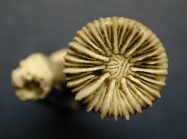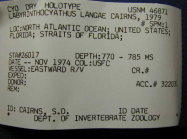WoRMS taxon details
Labyrinthocyathus Cairns, 1979
267538 (urn:lsid:marinespecies.org:taxname:267538)
accepted
Genus
Labyrinthocyathus langae Cairns, 1979 (type by original designation)
- Species Labyrinthocyathus delicatus (Marenzeller, 1904)
- Species Labyrinthocyathus facetus Cairns, 1979
- Species Labyrinthocyathus langae Cairns, 1979
- Species Labyrinthocyathus limatulus (Squires, 1964)
- Species Labyrinthocyathus quaylei (Durham, 1947)
- Species Labyrinthocyathus cornu (Moseley, 1880) accepted as Crispatotrochus cornu (Moseley, 1880) (unaccepted > superseded combination)
- Species Labyrinthocyathus langi Cairns, 1979 accepted as Labyrinthocyathus langae Cairns, 1979 (unaccepted > incorrect grammatical agreement of specific epithet)
marine, fresh, terrestrial
recent + fossil
Cairns, S.D. (1979). The deep-water Scleractinia of the Caribbean and adjacent waters. <em>Studies on the Fauna of Curaçao and other Caribbean Islands.</em> 57:1-341. [details] Available for editors  [request]
[request]
Depth range 20-1000 m
Fossil range Eocene to Recent
Depth range 20-1000 m [details]
Fossil range Eocene to Recent
Fossil range Eocene to Recent [details]
Hoeksema, B. W.; Cairns, S. (2024). World List of Scleractinia. Labyrinthocyathus Cairns, 1979. Accessed through: World Register of Marine Species at: https://www.marinespecies.org/aphia.php?p=taxdetails&id=267538 on 2024-04-28
Date
action
by
![]() The webpage text is licensed under a Creative Commons Attribution 4.0 License
The webpage text is licensed under a Creative Commons Attribution 4.0 License
original description
Cairns, S.D. (1979). The deep-water Scleractinia of the Caribbean and adjacent waters. <em>Studies on the Fauna of Curaçao and other Caribbean Islands.</em> 57:1-341. [details] Available for editors  [request]
[request]
context source (Hexacorallia) Fautin, Daphne G. (2013). Hexacorallians of the World. (look up in IMIS) [details]
basis of record van der Land, J. (ed). (2008). UNESCO-IOC Register of Marine Organisms (URMO). , available online at http://www.marinespecies.org/urmo/ [details]
additional source Randall RH. (2003). An annotated checklist of hydrozoan and scleractinian corals collected from Guam and other Mariana Islands. <em>Micronesica.</em> 35-36: 121-137.
page(s): 135 [details]
additional source Cairns, S.D. & H. Zibrowius. (1997). Cnidaria Anthozoa: Azooxanthellate Scleractinia from the Philippine and Indonesian regions. <em>in: Crosnier, A. et al. (Ed.) Résultats des Campagnes MUSORSTOM 16. Campagne Franco-Indonésienne KARUBAR. Mémoires du Muséum national d'Histoire naturelle. Série A, Zoologie.</em> 172: 27-244. (look up in IMIS)
page(s): 61, 73, 104-105, 218, fig. 10 f, fig. 10 i [details] Available for editors [request]
[request]
additional source Cairns, S.D., L. Gershwin, F.J. Brook, P. Pugh, E.W. Dawson, O.V.; Ocaña, W. Vervoort, G. Williams, J.E. Watson, D.M. Opresko, P. Schuchert, P.M. Hine, D.P. Gordon, H.I. Campbell, A.J. Wright, J.A.Sánchez & D.G. Fautin. (2009). Phylum Cnidaria: corals, medusae, hydroids, myxozoans. <em>in: Gordon, D.P. (Ed.) (2009). New Zealand inventory of biodiversity: 1. Kingdom Animalia: Radiata, Lophotrochozoa, Deuterostomia.</em> pp. 59-101., available online at https://repository.si.edu/handle/10088/8431 [details] Available for editors [request]
[request]
additional source Cairns, S.D., R. Baron-Szabo, A.F. Budd, B. Lathuilière, E. Roniewicz, J. Stolarski & K.G. Johnson. (2010). Corallosphere. , available online at http://www.corallosphere.org [details]
redescription Cairns, S.D. (1995). The marine fauna of New Zealand: Scleractinia (Cnidaria: Anthozoa. <em>New Zealand Oceanographic Memoir.</em> 103: 1-210. [details] Available for editors [request]
[request]
context source (Hexacorallia) Fautin, Daphne G. (2013). Hexacorallians of the World. (look up in IMIS) [details]
basis of record van der Land, J. (ed). (2008). UNESCO-IOC Register of Marine Organisms (URMO). , available online at http://www.marinespecies.org/urmo/ [details]
additional source Randall RH. (2003). An annotated checklist of hydrozoan and scleractinian corals collected from Guam and other Mariana Islands. <em>Micronesica.</em> 35-36: 121-137.
page(s): 135 [details]
additional source Cairns, S.D. & H. Zibrowius. (1997). Cnidaria Anthozoa: Azooxanthellate Scleractinia from the Philippine and Indonesian regions. <em>in: Crosnier, A. et al. (Ed.) Résultats des Campagnes MUSORSTOM 16. Campagne Franco-Indonésienne KARUBAR. Mémoires du Muséum national d'Histoire naturelle. Série A, Zoologie.</em> 172: 27-244. (look up in IMIS)
page(s): 61, 73, 104-105, 218, fig. 10 f, fig. 10 i [details] Available for editors
additional source Cairns, S.D., L. Gershwin, F.J. Brook, P. Pugh, E.W. Dawson, O.V.; Ocaña, W. Vervoort, G. Williams, J.E. Watson, D.M. Opresko, P. Schuchert, P.M. Hine, D.P. Gordon, H.I. Campbell, A.J. Wright, J.A.Sánchez & D.G. Fautin. (2009). Phylum Cnidaria: corals, medusae, hydroids, myxozoans. <em>in: Gordon, D.P. (Ed.) (2009). New Zealand inventory of biodiversity: 1. Kingdom Animalia: Radiata, Lophotrochozoa, Deuterostomia.</em> pp. 59-101., available online at https://repository.si.edu/handle/10088/8431 [details] Available for editors
additional source Cairns, S.D., R. Baron-Szabo, A.F. Budd, B. Lathuilière, E. Roniewicz, J. Stolarski & K.G. Johnson. (2010). Corallosphere. , available online at http://www.corallosphere.org [details]
redescription Cairns, S.D. (1995). The marine fauna of New Zealand: Scleractinia (Cnidaria: Anthozoa. <em>New Zealand Oceanographic Memoir.</em> 103: 1-210. [details] Available for editors
 Present
Present  Inaccurate
Inaccurate  Introduced: alien
Introduced: alien  Containing type locality
Containing type locality
Nontype MNHN, geounit Indonesian Exclusive Economic Zone [details]
Nontype USNM 94129, geounit New Zealand Exclusive Economic Zone [details]
From editor or global species database
Comparison Like Crispatotrochus but having a labyrinthiform columella. [details]Diagnosis Corallum solitary, ceratoid to trochoid, firmly attached; costae inconspicuous; no endotheca; pali absent; columella labyrinthiform (composed of interconnecting network of lamellar plates). [details]
Remark Five Recent species and two fossil species. [details]
From other sources
Biology azooxanthellate [details]Depth range 20-1000 m [details]
Fossil range Eocene to Recent [details]
Habitat Known from seamounts and knolls [details]


